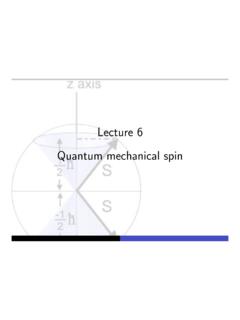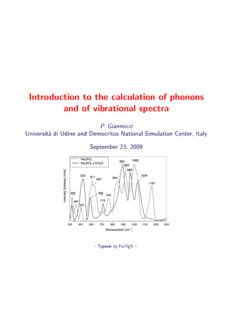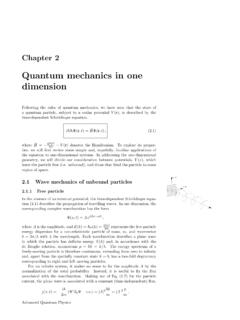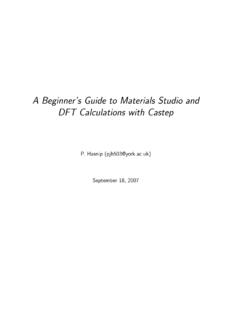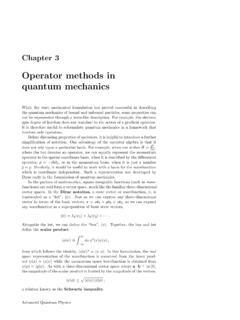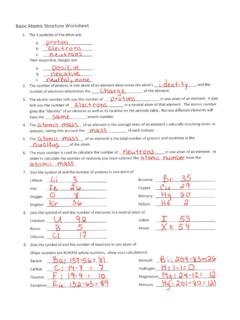Transcription of Lecture 12 Atomic structure - TCM Group
1 Lecture 12. Atomic structure Atomic structure : background Our studies of hydrogen-like atoms revealed that the spectrum of the Hamiltonian, p 2 1 Ze 2. H 0 = . 2m 4 "0 r is characterized by large n2 -fold degeneracy. However, although the non-relativistic Schro dinger Hamiltonian provides a useful platform, the formulation is a little too na ve. The Hamiltonian is subject to several classes of corrections , which lead to important physical ramifications (which reach beyond the realm of Atomic physics). In this Lecture , we outline these effects, before moving on to discuss multi-electron atoms in the next.
2 Atomic structure : hydrogen atom revisited As with any centrally symmetric potential, stationary solutions of H 0 index by quantum numbers n#m, n!m (r) = Rn! (r )Y!m ( , ). For Atomic hydrogen, n2 -degenerate energy levels set by ! 2. "2. 1 e m e2 1. En = Ry 2 , Ry = 2. =. n 4 "0 2! 4 "0 2a0. 4 #0 !2. where m is reduced mass (ca. electron mass), and a0 = e2 m . For higher single-electron ions (He+ , Li2+ , etc.), En = Z 2 Ry n2 . Allowed combinations of quantum numbers: n # Subshell(s). 1 0 1s 2 0, 1 2s 2p 3 0, 1, 2 3s 3p 3d n 0 (n 1) ns . Atomic structure : hydrogen atom revisited However, treatment of hydrogen atom inherently non-relativistic: p 2 1 Ze 2.
3 H 0 = . 2m 4 "0 r is only the leading term in relativistic treatment (Dirac theory). Such relativistic corrections begin to impact when the electron becomes relativistic, v c. Since, for Coulomb potential, 2# $ = # $ (virial theorem), 1. 2 mv 2. = # $ = E 000 = Z 2. Ry. Using identity, 1 e2 1 1. Z Ry = mc 2 (Z )2 , 2. = %. 2 4 "0 !c 137. v where denotes the fine structure constant, we find = Z . c The real hydrogen atom: outline Terms of higher order in vc = Z provide relativistic corrections which lead to lifting of the degeneracy. These corrections (known as fine- structure ) derive from three (superficially) different sources: (a) relativistic corrections to the kinetic energy.
4 (b) coupling between spin and orbital degrees of freedom;. (c) and a contribution known as the Darwin term. (a) Relativistic corrections to kinetic energy From the relativistic energy-momentum invariant, # p2 1 (p2 )2. 2. E= p2 c 2 + m2 c 4 = mc + 3 2. + , 2m 8 m c we can anticipate the leading correction to the non-relativistic Hamiltonian is given by 1 (p 2 )2. H 1 = . 8 m3 c 2. The relative scale of perturbation #H 1 $ p2 v2. % 2 2 = 2 % (Z )2. #H 0 $ m c c e2 1 1. where = 4 #0 !c % 137 . H 1 is only a small perturbation for small Atomic number, Z . (a) Relativistic corrections to kinetic energy 1 (p 2 )2.
5 H 1 = . 8 m3 c 2. Since [H 1 , L 2 ] = 0 and [H 1 , L z ] = 0, #n#m|[H 1 , L 2 ]|n#! m! $ = !2 [#! (#! + 1) #(# + 1)] #n#m|H 1 |n#! m! $ = 0. #n#m|[H 1 , L z ]|n#! m! $ = !(m! m)#n#m|H 1 |n#! m! $ = 0. Therefore, the off-diagonal matrix elements vanish: #n#m|H 1 |n#! m! $ = 0 for # &= #! or m &= m! and we can estimate energy shift without having to invoke degenerate perturbation theory. (a) Relativistic corrections to kinetic energy Making use of the identity, 1 (p 2 )2 1 $ %2 Ze 2 1. H 1 = = H 0 V (r ) , V (r ) = . 8 m3 c 2 2mc 2 4 "0 r scale of resulting energy shift can be obtained from first order perturbation theory, 1 & 2 2.
6 '. #n#m|H 1 |n#m$ = E 2En #V (r )$n! + #V (r )$n! 2mc 2 n Using the identities, ( ) ( ). 1 Z 1 Z2. = , = 2 3 . r n! a0 n2 r2 n! a0 n (# + 1/2). resulting energy shift acquires angular momentum dependence: 2. ! "4 ! ". mc Z n 3. #H 1 $n!m = . 2 n # + 1/2 4. (b) Spin-orbit coupling Spin degree of freedom of electron emerges naturally from relativistic formulation of quantum mechanics. Alongside the spin, this formulation leads to a further relativistic correction which involves coupling between spin and orbital degrees of freedom. For a general potential V (r ), this spin-orbit coupling is given by: 1 1.
7 H 2 = 2 2. ( r V ) L S . 2m c r 1 Ze 2. For a hydrogen-like atom, V (r ) = 4 #0 r and 1 1 Ze 2. H 2 = L S . 2m2 c 2 4 "0 r 3. (b) Spin-orbit coupling: physical origin Physically, as electron moves through electric field of nucleus, E = V (r ) = e r ( r V ), in its rest frame it will experience a magnetic field, B = c12 v E. In this field, the spin magnetic moment of the electron, s = me S, leads to an additional interaction energy, e e 1. s B = 2. S (p e ( . r r V )) = 2. ( r V )L S. (mc) (mc) r where we have used the relation p e r = 1r L. Additional factor of 1/2 derives from further relativistic effect known as Thomas precession.
8 Those discontent with heuristic derviation need only wait for Dirac (b) Spin-orbit coupling 1 1 Ze 2. H 2 = L S . 2m2 c 2 4 "0 r 3. Without spin-orbit interaction, eigenstates of hydrogen-like atoms can be expressed in basis of mutually commuting operators, H 0 , L 2 , L z , S 2 , and S z . However, with spin-orbit, total Hamiltonian no longer commutes with L z or S z useful to exploit degeneracy of H 0 to switch to new basis in which L S is diagonal. Achieved by turning to basis of eigenstates of the operators, H 0 , J 2 , J z , L 2 , and S 2 , where J = L + S . Since J 2 = L 2 + S 2 + 2L S , it follows that, 1 2 2 2 1.
9 L S = (J L S ) = (j(j + 1) #(# + 1) s(s + 1)). 2 2. (b) Spin-orbit coupling 1 2 2 2 1. L S = (J L S ) = (j(j + 1) #(# + 1) s(s + 1)). 2 2. 1 1 Ze 2. H 2 = 2 2 3. L S . 2m c 4 "0 r Combining spin 1/2 with angular momentum #, total angular momentum can take values j = # 1/2. Corresponding basis states |j = # 1/2, mj , #$ diagonalize operator, ! ". ! 2. #. L S |j = # 1/2, mj , #$ = |# 1/2, mj , #$. 2 # 1. Once again, off-diagonal matrix elements of H 2 vanish allowing correction to be computed in first order perturbation theory. ! " ( ). 1 ! 2. # Ze2. 1. #H2 $n,j=! 1/2,mj ,! =. 2m2 c 2 2 # 1 4 "0 r3 n!
10 (b) Spin-orbit coupling ! " ( ). 1 ! 2. # Ze2. 1. #H2 $n,j=! 1/2,mj ,! =. 2m2 c 2 2 # 1 4 "0 r3 n! Making use of identity, ( ) ! "3. 1 mc Z 1. = , #>0. r 3 n! !n #(# + 1/2)(# + 1). ! "4 *. 1. 1 Z n j = # + 1/2. #H 2 $n,j=! 1/2,mj ,! = mc 2 j 1. 4 n j + 1/2 j+1 j = # 1/2. Rewriting expression for #H 1 $ in new basis |n, j = # 1/2, mj , #$, ! "4 * 1. 1 2 Z j j = # + 1/2. #H 1 $n,j=! 1/2,mj ,! = mc n 1 . 2 n j+1 j = # 1/2. Combining these expressions, for # > 0, we have 4. ! ". 1 (Z ) 3 n (c) Darwin term Final relativistic correction arises from Zitterbewegung of electron giggling which smears effective potential felt by electron, !
